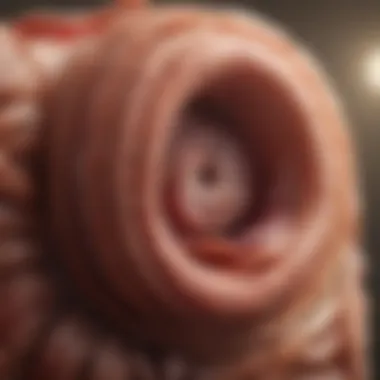Understanding Dietary Causes of Diarrhea in Dogs


Intro
Canine health often begins with diet. Understanding what dogs eat is vital to safeguarding their digestive systems. This article delves into how various dietary elements can lead to diarrhea in dogs. By learning the causes, pet owners can better manage their dogs’ nutrition and prevent gastrointestinal distress.
Understanding Your Pet
A dog’s breed, temperament, and individual needs greatly influence its health, including its susceptibility to digestive issues.
Breed Traits
Different dog breeds have distinct digestive systems. For example, Bulldogs often experience more gastrointestinal issues due to their anatomy. Labrador Retrievers, on the other hand, may be prone to overeating, impacting their digestion. Understanding breed-specific traits can help owners anticipate and address potential dietary problems.
Common Temperaments
Temperament also plays a role. An anxious dog may react negatively to certain foods, leading to diarrhea. Calm dogs might have fewer reactions but still require attention to their diet. Observing your pet's reactions during feeding can help identify troubling food items.
Special Needs
Some dogs may have special dietary needs due to medical conditions. Allergies, for instance, are common and can be triggered by specific proteins or grains. Understanding these requirements ensures that you provide an appropriate diet, reducing the risk of gastrointestinal upset.
Pet Care Essentials
Proper pet care goes beyond basic feeding. Nutrition, grooming, and overall wellness are intertwined in maintaining good health.
Nutrition and Feeding Guidelines
Start with a balanced diet. High-quality dog food, like Royal Canin or Hill's Science Diet, ensures proper nutrition. Always introduce new foods gradually to avoid upsetting your dog's stomach. The following practices can help:
- Stick to a schedule: Regular feeding times help prevent overeating.
- Monitor portion sizes: Adjust portions based on your dog's activity level.
- Avoid table scraps: Human food can disrupt a dog's digestive balance.
Grooming Tips and Techniques
While grooming does not directly relate to diet, it helps in managing overall health. Regular brushing removes loose fur and can prevent skin infections, which indirectly supports a dog's digestion by preventing stress and discomfort that can cause diarrhea.
Health and Wellness
Regular vet check-ups are crucial for early identification of dietary sensitivities. Discuss changes in diet or signs of digestive disturbances with your veterinarian for tailored advice.
Regular health check-ups can catch early signs of dietary issues, enabling preventive measures for your dog's well-being.
Training and Behavior
Training impacts a dog's approach to food. A well-trained dog is less likely to scavenge, which reduces the risk of consuming undesirable items.
Basic Training Techniques
Encourage obedience around food. Teach commands like
Preamble to Canine Digestive Health


Understanding canine digestive health is crucial in preventing and managing conditions such as diarrhea in dogs. A well-functioning digestive system is central to the overall health and well-being of a dog. It plays a role in nutrient absorption and waste elimination and influences the immune response. Inadequate knowledge about canine digestion can lead to dietary mistakes, potentially harming the dog’s health.
The canine digestive system is uniquely designed for their dietary needs. It processes various foods that may be beneficial or harmful. Without understanding this mechanism, pet owners may inadvertently introduce food that disrupts digestive balance, leading to gastrointestinal distress. Knowing the anatomy and function of the digestive system is foundational for identifying food sources that could trigger diarrhea.
In this section, we will cover how the dog's digestive structure works and what happens during digestion. This overview sets the stage for discussing specific dietary causes of diarrhea and how to manage them effectively.
Overview of Dog Digestive Anatomy
The anatomy of a dog’s digestive system is composed of several key components, each playing a distinct role in how food is processed. Food enters through the mouth, where it is mechanically broken down. From there, it travels through the esophagus and into the stomach, where the actual digestion starts.
- Mouth: It begins the process by chewing and mixing food with saliva, which contains enzymes that start breaking down carbohydrates.
- Stomach: The stomach further processes the food using gastric acids and enzymes. It converts food into a semi-liquid form called chyme.
- Small Intestine: This is where most digestion and nutrient absorption occurs. The pancreas and liver contribute digestive enzymes and bile to aid in breaking down fats, proteins, and carbohydrates.
- Large Intestine: It absorbs water and electrolytes, forming solid waste to be expelled. If food moves too quickly through this section, diarrhea may occur due to inadequate water absorption.
Understanding this structure is critical. It helps pet owners appreciate how certain foods might affect digestion and health.
What Happens During Digestion?
Digestion in dogs involves a series of complex processes that convert food into nutrients and waste. This journey can be broken down into several stages:
- Ingestion: The process begins with the dog consuming food. This includes chewing and swallowing.
- Transport: Food moves from the mouth through the esophagus into the stomach. The sphincters help in preventing backflow and allow unidirectional flow.
- Digestion: In the stomach, enzymes and acids break down food into simpler forms. However, the duration food spends here is vital. A dog eating overly rich or unsuitable foods can lead to excessive gastric secretions.
- Absorption: Once food enters the small intestine, nutrients are absorbed into the bloodstream through the intestinal walls. Here, the quality of what is consumed becomes pivotal.
- Elimination: Finally, leftover waste is pushed into the large intestine, where water reabsorption occurs before being expelled.
A disruption at any stage can lead to health issues. For example, sudden diet changes can upset this delicate process, leading to problems like diarrhea. Knowledge of these processes aids pet owners in making informed dietary choices.
Common Foods Associated with Dog Diarrhea
Understanding the dietary factors that contribute to diarrhea in dogs is crucial for pet owners. Certain foods can trigger gastrointestinal distress, leading to unpleasant situations for both the dog and the owner. Identifying these foods helps in preventing occurrences of diarrhea and maintaining overall health for canine companions. Furthermore, it allows caregivers to make informed decisions about what they feed their dogs. This section highlights foods commonly associated with diarrhea and explains their specific impacts on canine digestion.
Dairy Products and Lactose Intolerance
Many dogs experience lactose intolerance, meaning they struggle to digest lactose, the sugar found in milk and dairy products. This condition arises due to a lack of lactase, the enzyme responsible for breaking down lactose in the digestive system. Feeding dogs cheese, milk, or yogurt can lead to symptoms such as bloating, gas, and diarrhea.
- Symptoms of lactose intolerance:
- Diarrhea
- Abdominal pain
- Excessive gas
Pet owners should monitor their dog's reaction to dairy. Avoiding these products can help maintain their digestive health.
High-Fat Foods and Oil Content
High-fat foods can significantly impact a dog's digestion. Foods such as fried items or fatty cuts of meat can lead to pancreatitis, an inflammation of the pancreas, which results in severe diarrhea and vomiting. Dogs are not equipped to handle excessive fat intake, making it essential to avoid these items.
- Risky fats:
- Bacon
- Sausage
- Some fast food
Maintain a balanced diet for dogs by limiting high-fat food exposure. Rather, opt for lean proteins like chicken or turkey without the skin and excessive oils.
Certain Fruits and Vegetables
Some fruits and vegetables are safe for dogs, but others can cause digestive upset. For instance, grapes and raisins are highly toxic, leading to kidney failure in dogs, while certain vegetables like onions and garlic are harmful as well. Even safe fruits can be challenging if consumed in large quantities, leading to bowel irritations.
- Fruits and vegetables to avoid:


- Grapes
- Raisins
- Onions
- Garlic
Keep an eye on the types of produce introduced into a dog's diet. Always consult with a veterinarian before offering new fruits and vegetables.
Processed and Spoiled Foods
Processed foods carry preservatives and additives that can upset a dog's sensitive stomach. Spoiled or expired food can lead to bacterial infections, resulting in diarrhea among other gastrointestinal issues. Recognizing fresh, high-quality ingredients is vital for responsible dog ownership.
- Key considerations:
- Check expiration dates
- Observe consistency and smell of food
- Avoid junk food and highly processed snacks
Ensuring a dog's diet consists of fresh ingredients contributes to a healthy digestion and reduces the risk of diarrhea. Regularly reviewing food quality is essential for maintaining canine health.
Individual Food Sensitivities in Dogs
Understanding individual food sensitivities in dogs is vital to maintaining their digestive health. Just like humans, dogs can have unique reactions to certain foods. Identifying these sensitivities can prevent serious gastrointestinal disturbances, including diarrhea.
Food sensitivities may manifest in various ways, such as skin irritations, behavioral changes, or digestive upsets. For pet owners, recognizing these signs early can lead to appropriate dietary adjustments and improved overall health for their canine companions.
Identifying Common Allergens
Identifying common allergens is essential in preventing dietary-induced diarrhea. Certain ingredients are more prone to causing negative reactions in dogs. Common allergens include:
- Beef
- Chicken
- Wheat
- Soy
- Lamb
- Dairy products
Each dog may respond differently to these ingredients. Therefore, owners should monitor their pets closely when introducing new foods or changing their diet. Keeping a food diary can be beneficial for tracking any occurrences of diarrhea linked with specific foods.
A veterinarian’s guidance may also be necessary when identifying and confirming food sensitivities. Allergy tests or elimination diets might be employed for a more accurate diagnosis, ensuring pets avoid harmful ingredients while still receiving balanced nutrition.
The Role of Genetics in Food Reactions
Genetics play a notable role in food reactions in dogs. Some breeds are more predisposed to food allergies than others. For example, breeds such as the Labrador Retriever, Cocker Spaniel, and Boxer are known to have higher incidences of food sensitivities.
Understanding the genetic background of a dog allows owners to be proactive. If a breed is known for specific sensitivities, pet owners can be cautious with their dietary choices. Noting family history and any observed sensitivities can provide insights into an individual dog's reactions.
In summary, recognizing food sensitivities requires a combination of awareness, monitoring, and sometimes professional assistance. With the right approach, pet owners can ensure their dogs enjoy a productive and healthy life.
Impact of Sudden Dietary Changes
Changing a dog's diet abruptly can have significant implications on their digestive health. When introducing new food, it is essential to recognize that a dog's gastrointestinal system is sensitive. A sudden shift in diet can lead to diarrhea, which is often a sign that the dog's intestines are struggling to adapt to the new ingredients. This section explores the benefits of gradual introduction of new foods and signs to look for during this transitional period.
Introducing New Foods Gradually
Transitioning to new dog food should not be a rushed process. It is recommended to introduce new foods over a span of at least a week. By gradually mixing the new food with the old one, dog owners can minimize potential adverse effects. A common approach is the 70/30 method, where 70% of the current diet is maintained while 30% is the new variety for the first few days. Gradually, this can shift to a 50/50 mix for another few days before fully committing to the new diet. Keeping a watchful eye on your dog's reaction during this change is crucial.
- Observe your dog for any unusual behaviors, such as lethargy or increased urination.
- Note the consistency of their stool. A simple chart could help in tracking these changes.
- Make adjustments if necessary, returning to the previous diet if signs of distress arise.
This slow introduction gives the digestive system a chance to adjust. If the transition is too abrupt, it can lead to gastrointestinal upset, including diarrhea or vomiting. Ultimately, a gradual methodology fosters a healthier eating habit.
Signs of Digestive Distress


When a dog experiences digestive distress, it can manifest in various ways, making it crucial for pet owners to recognize these signs so they can act quickly. The presence of one or several indicators may suggest that the new diet is not well-received. Common signs include:
- Diarrhea: Loose bowel movements can be alarming and are the most recognizable indication of digestive issues.
- Vomiting: This may occur alongside diarrhea and can signify an intolerable food.
- Bloating: Distended abdomen might indicate an unhealthy reaction to new foods.
- Refusal to eat: If a dog suddenly loses interest in eating or shows hesitance, it could mean discomfort related to their diet.
In some cases, a dog may exhibit behavioral changes, such as increased anxiousness or lethargy. If any of these symptoms persist or worsen, it is advisable to consult a veterinarian for proper assessment.
Remember that swift intervention is key. Maintaining an open dialogue with veterinary professionals can assist in customizing a diet that suits individual needs, ultimately ensuring your dog's health and happiness.
Safe Alternative Foods for Dogs
Understanding the importance of safe alternative foods for dogs is crucial for pet owners seeking to mitigate the risks of dietary-induced diarrhea. Dogs, like humans, can have varied reactions to different food types. Identifying safe alternatives not only helps in preventing gastrointestinal upsets but also supports overall canine health. In this section, we will explore digestive-friendly options and homemade diets, while emphasizing the need for awareness regarding nutritional balance.
Digestive-Friendly Options
When it comes to selecting digestive-friendly options for dogs, aim for foods that are known to be gentle on their gastrointestinal systems. Good choices include:
- Boiled Chicken: Lean meat without skin provides protein without excess fat.
- Rice: Plain white rice is bland and easy to digest, making it a staple for dogs recovering from digestive issues.
- Pumpkin: Pure pumpkin can aid digestion and is high in fiber, helping to firm up stools.
- Sweet Potatoes: These are high in fiber and vitamins, offering a nutritious alternative.
Including these foods in a dog's diet can help stabilize digestive health. However, it’s important to introduce any new food carefully and observe for any adverse reactions.
Homemade Diets and Recipes
Creating homemade dog food can be rewarding and beneficial. It allows dog owners to control every ingredient, ensuring quality and suitability. Some simple recipes to consider include:
- Chicken and Rice Recipe: Combine boiled chicken, rice, and a small amount of carrots. This combination is complete and usually well tolerated.
- Sweet Potato and Lean Beef Mix: Cook lean ground beef with sweet potatoes and some peas. This offers a nutritious and balanced meal.
- Pumpkin Puree with Oatmeal: Mix pumpkin puree with cooked oatmeal. This recipe can be soothing for sensitive tummies.
Tip: Always consult a veterinarian before making significant changes to your dog's diet, particularly when considering homemade options.
The End: Best Practices for Preventing Diarrhea
In the journey of keeping your dog healthy, understanding dietary causes of diarrhea stands out as a key aspect. This segment emphasizes best practices that can significantly reduce the likelihood of gastrointestinal distress in dogs. By implementing these measures, pet owners can safeguard their furry companions from potential discomfort.
Regular Monitoring of Diet
One of the primary steps in preventing diarrhea is regular monitoring of diet. Be attentive to what your dog consumes. This includes not only their main meals but also any snacks or treats you may offer.
- Keep a Food Diary: Document the foods your dog ingests, particularly when trying new items. This allows you to identify patterns and possible triggers when digestive issues arise.
- Transition Foods Gradually: When changing a dog's diet, introduce new ingredients slowly over several days. A sudden shift can disrupt your dog's digestive system, leading to diarrhea.
- Observe Reactions: After introducing a new food, pay close attention to your dog’s reaction. If signs of diarrhea appear, it may indicate an intolerance or sensitivity to that ingredient.
Consulting Veterinary Professionals
Consulting veterinary professionals is essential for any concerns regarding your dog's health. They can provide insights that go beyond basic knowledge.
- Professional Guidance: A vet can help in determining food allergies or sensitivities. They might recommend specialized testing or dietary plans tailored for your dog's needs.
- Dietary Recommendations: Based on your dog's health history, your vet can suggest suitable diets or specific brands that are less likely to cause digestive issues.
- Regular Check-Ups: Regular veterinary visits play a crucial role in overall health. A vet can monitor your dog’s condition and dietary needs, ensuring that preventive measures are effective.
Proper nutrition is the cornerstone of canine health. A proactive approach to monitoring diet and consulting with professionals can lead to a significant reduction in cases of diarrhea.
By combining these best practices, pet owners can create an environment that nurtures their dog's digestive health. It’s essential to be vigilant, informed, and proactive in managing your dog's diet for long-term well-being.
Help Sections About Dog Diarrhea and Diet
Understanding the dietary causes of diarrhea in dogs is crucial for pet owners. This section addresses frequently asked questions, dispelling myths and providing effective nutritional practices to enhance dog health. The importance lies in raising awareness about common misconceptions while equipping owners with reliable, informative best practices.
Common Myths Regarding Dog Food
Many pet owners hold misconceptions about dog food that can adversely affect their dog's health. Addressing these myths can aid in making better dietary choices. Here are some prevalent beliefs:
- Dogs can digest everything like humans: This is incorrect. Canine digestive systems are different. Foods harmful to dogs can cause diarrhea or other health issues.
- Dry food is only bad for dogs: While some dry foods may lack essential nutrients, many are nutritionally complete and safe. Selection should focus on quality ingredients.
- Grains are harmful to dogs: This is a misunderstanding. Many dogs thrive on diets that include grains. The key lies in identifying individual dietary allergies or intolerances.



